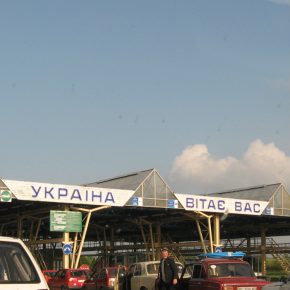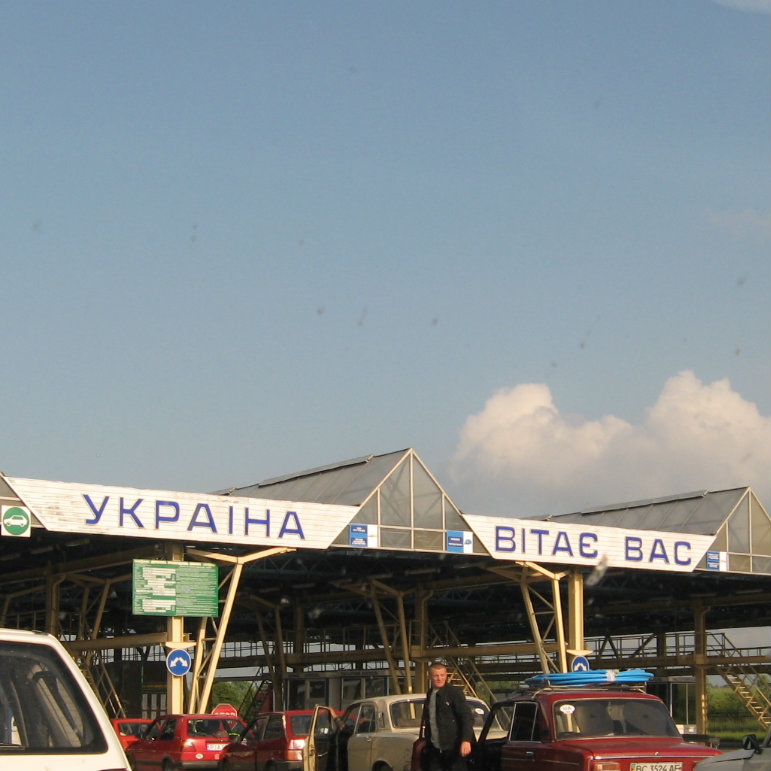Tydzień w gospodarce
Category: Trendy gospodarcze

Polish-Ukrainian border (Go Travel, CC BY)
CE Financial Observer: “Dziennik Gazeta Prawna” announced that Polish employers are able to employ up to one million Ukrainians this year and described Warsaw as the “London of Eastern Europe”. Will as many as a million employees really support Poles without any efforts from Poland’s side?
Paweł Kaczmarczyk: The “London of Eastern Europe” is a catchy phrase but for me it’s an overstatement. The same as “a million Ukrainians”. We know that there are tens of thousands of people with a work permit staying in Poland and that last year almost 800,000 statements of intention to employ foreigners were issued. However, it is also known that, for various reasons, only 60–70 per cent of those statements are really used. This means that the actual number of Ukrainians benefiting from the simplified procedure is much lower.
The Polish central bank, Narodowy Bank Polski (NBP), estimates that the group of Ukrainians coming to Poland every year amounts to exactly one million. However, as they work only for few months a year, the average number of Ukrainians staying in Poland is 500,000.
I think I can agree with these estimations. Besides, even half a million people is a lot, bearing in mind the size of the Polish labor market. Suffice it to say that, in terms of seasonal employment, Poland is one of the leading countries in Europe. And as you quite rightly pointed out, in recent years Poland didn’t have to do almost anything to become such a leader.
Why do Ukrainians come to Poland in such huge numbers?
Because as early as in 2006, the then Deputy Prime Minister and Minister of Agriculture, Andrzej Lepper implemented a system of employers’ statements which allowed foreigners from the former Soviet Union countries to undertake seasonal work in agriculture without having to go through the burdensome procedure of applying for a work permit. That was an ad hoc legislation but until today the majority of Ukrainians benefit from the system of employers’ statements. It proved to be very effective when it comes to the inflow of foreigners seeking employment and less effective when it comes to identifying their actual number, indicating sectors they work in and controlling possible misuse.
The armed conflict in eastern Ukraine has probably contributed to an increased number of trips to Poland?
Yes. This is undoubtedly an important catalyst. All post-2014 data suggest that. The deepening economic crisis, affecting the whole of Ukraine, seems to be a factor of a bigger importance. The western part of Ukraine is very close to Poland and wages here are four or five times higher. The determination of Ukrainians has significantly increased. While before 2014 those coming to Poland had secured a job before their arrival here, at present an increasing number of people come and look for a job only when they arrive in Poland. As a result, an unprecedented phenomenon has emerged – unemployed Ukrainians in Poland.
According to a stereotype, Ukrainian men find work in agriculture and the construction industry while Ukrainian women work as domestic helpers?
To a large extent, yes. But for me, at present the most interesting is another group – students. It is beyond doubt that some of them use studies in Poland to find employment. However, a growing number of young people from Ukraine want to improve their competences and skills and, instead of studying in Ukraine, they choose Warsaw, or go more south and choose Lublin or Rzeszów. Their future is not yet decided: will they stay in Poland, will they move further west, or will they come back to Ukraine once the situation there improves?
Is it possible to estimate the number of Ukrainians for whom Poland is a transit country to, for example, Germany?
Unfortunately, we do not know that. Moreover, the issue is much more complex than a simple comparison of wages would suggest. Wages in Germany and the UK are among the highest in Europe, but there are relatively few Ukrainian citizens there. Yet, Ukrainians are in Poland, Italy and Spain.
The demand for labor in individual sectors is a decisive factor. The three latter countries show high demand for physical labor in the construction and agriculture and high demand for labor in domestic services. In the case of Poland, the phenomenon is additionally based on a network of migration connections, because the tradition of migrations between Ukraine and Poland dates back to the beginning of 1990s.
Does Ukraine remain the center of life of the immigrants?
Yes. A prevailing model is that a person works in Poland for few months and spends few months with family in Ukraine. This is clearly visible when we look at migrant women. Those for whom the focal point in life is their family in Ukraine come to Poland, while those who do not rule out a permanent stay outside their country go to Italy and Spain.
In the countries of Southern Europe, work in the domestic services is more often connected with care for elderly people, and this requires a permanent presence in the country, and often living in the employer’s house. It is worth noting, however, that even though a significant number of Ukrainian citizens are seasonal workers in Poland, many of them started their “migration careers” in the 1990s or at the beginning of this century.
The survey carried out by NBP shows that Ukrainians working in Poland earn approximately PLN2,000 on average, often illegally. Can Poland afford having immigration that preserves low-paid jobs and does not allow wages to be increased?
We would like to examine this, especially as regards Polish agriculture. It can be assumed that if there were no Ukrainians, Polish farmers would be forced to shift towards more capital-intensive production methods.
For the time being, however, intuition suggests that it would not be a mass phenomenon. It is not easy to mechanize gardening or the harvesting of fruit. To the same extent, it is difficult to substitute manual labor at construction sites or in the case of domestic services. Even in rich and developed countries such tasks are performed by immigrants because local workers do not want to take them up.
Don’t Ukrainians compete for work with Poles?
In most cases no, because the term “competition” assumes that Poles at least try to take up jobs in the same sector, whereas that is not the case. I understand, of course, that you ask about a “race to the bottom” which means rivalry pulling wages down to such an extent that in some sectors domestic workers have no chance at all. This problem may appear in Poland but in the distant future.
Why?
First of all, because in some sectors, short-term deficits in work supply are a fact. Secondly, it is due to demography. In Poland, the number of people in the productive age is already decreasing, and in the next five to ten years these changes will be dramatic. Ukraine is struggling with even worse demographic problems. Year by year, there will be fewer workers in Poland, but the number of Ukrainians coming to Poland may also decline. Under such conditions, it is difficult to imagine a race to the bottom in wages and a deterioration of employment conditions on a massive scale, though of course adverse sectorial effects cannot be excluded.
How should Poles convince Ukrainians to stay in Poland? An immigration policy is probably needed, but to be more specific, what kind of policy?
The phrase “fight for the Ukrainians” would suggest that Poland should implement some sort of recruitment policy which seems rather unrealistic in the current political situation in Europe. Nevertheless, Ukrainians are in Poland, they are still coming here in huge numbers and Poland should make use of this situation. Let me draw your attention to three aspects.
Firstly, chances related to the presence of the Ukrainian students in Poland should be better identified. They are not only a chance for many Polish universities to survive, but also in the longer term, they are a potential source of well-qualified and partly integrated labor force. Secondly, before Poland starts looking abroad for qualified workers, it should realize that they are already in the country, often working below their qualifications, as they pick strawberries or clean houses. We only need to recognize and master their skills (although the word “only” is exaggerated because there are few countries in the world which have managed it). Thirdly, Poland should offer the possibility to settle in the country or even gradually qualify for Polish citizenship for those who circulate between Poland and Ukraine, and also for those who benefit today from the simplified procedure and get visas on the basis of the employer’s statement.
And what about Poles who are expected to return to Poland after Brexit? Aren’t they a solution to the demographic problem?
I guess that part of the so-called post-accession migration might have come back to Poland around 2008, but just then the economic crisis broke out and stopped them. Now, they are already firmly rooted in the UK. Also, the British are not so short-sighted to destroy a number of their economic sectors which depend on foreigners. I wouldn’t count at all on a mass return from the UK.
Over 2 million Poles generate other countries’ GDP, and their remittances to Poland account for around 1 per cent of Polish GDP. Is the balance of emigration from Poland positive?
This is not that easy to compare, as this is a question of two different perspectives. From the point of view of public interest, it would of course be better if those people worked in Poland, but not necessarily so from an individual perspective – that is a comparison of costs and benefits for a migrant and his or her family.
However, even from the first perspective, the issue is debatable because it could turn out that if those 2 million people had stayed in Poland, they would not have generated the equivalent of that 1 per cent of GDP which they currently transfer to Poland. Taking into account the labor market situation in Poland before accession to the EU, the cost of an alternative to migration does not necessarily have to be high.
It would be, if a lack of jobs was the main motive for leaving Poland. Was it?
No. Researches don’t indicate that the lack of jobs was the main reason for migration. The migration following Poland’s accession to the EU was above all the migration of young, quite well-educated people who could find employment in Poland but who were looking for a better employment abroad. Now, years later, what they find important is a high level of social safety – the belief that even working below their skills, at the proverbial ‘busboy’, they are able to support themselves and their families, and in the event of economic crisis they can count on government support.
So, the Poles won’t come back and the number of Ukrainians coming to Poland may not be sufficient. Maybe Vietnamese and Chinese will fill the vacancies?
No. Firstly, the scale of their influx, as compared to the Ukrainians, is much smaller. Secondly, their model of participation in the labor market is different. They are mainly business owners or persons employed in the ethnic economy – working for other Chinese or Vietnamese. It is more likely that in the future Poles will find jobs in their shops, restaurants and shopping centers. However, it is worth watching both these ethnic groups closely, not only because of the models of their professional activity but also because of the nature of their social integration.
Paweł Kaczmarczyk, PhD, is a Vice Director of the Centre of Migration Research of the University of Warsaw, Assistant Professor in the Faculty of Economic Sciences at the University of Warsaw.



